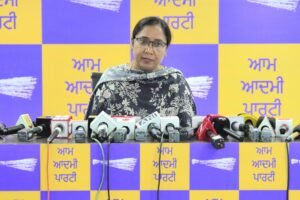The Fact News Service
The sudden and excessive monsoon rains that caused severe flooding with overflowing rivers caused massive losses in agriculture, human and animal life, and infrastructure in North India. Punjab is one of the worst hit states and the economy of the farming community, and the state in general, has been devastated. It seems that the farming community suffers almost every year due to increased climatic volatility, variable rainfall and temperature patterns, droughts, floods, heat, cold waves, and frosts and pest (insects and diseases) outbreaks. Unplanned use of land and the encroachment of river flood plains for non-agricultural activities have also contributed to problem. We can expect these issues to continue to plague the farming community over time. If proactive action is not taken to mitigate the impending challenges, we will continue to see heart wrenching scenes of sufferings, we saw with the recent flooding.
It is a sad situation that the past and the present governments, policy makers and development agencies seem to be so unprepared when sudden natural calamities occur. There remains an urgent need to carry out region-specific risk-analysis and formulate comprehensive action plans for integrated disaster management and ensuring effective implementation. The Punjab Water Regulation and Development Authority that was constituted in 2020 seems to have failed to provide any practical model for the management of rain and flood water and its conservation. It’s a shame millions of cusecs of water are going to flow to the ocean, instead of being harvested, conserved or channelized for use during dry spells. The state almost always remains unprepared to handle natural disasters – before, during and after the calamity. Its only after the devastation has happened, the government, development departments and other agencies seem to have been shaken awake, and the usual blame-game has started.
The need of the hour now is to compassionately address the present crisis. An empowered crisis management team must be constituted with representation from relevant departments (revenue, agriculture, irrigation and others), that can collaborate with agricultural institutions, financial institutions, farmers’ associations and local panchayats to address the challenges faced by the affected communities. There is urgent need to acknowledge the inadequacies of the existing infrastructure and develop suitable plans to prepare for facing any future natural disasters.
Below are some suggested actions:
• Top priority must be on formulating and effectively implementing action plans for economic rehabilitation of the affected farming community and rural populace and infrastructural (houses, roads, etc.) rejuvenation.
• The State department of agriculture and Punjab Agricultural University must immediately give recommendation about the short duration crops and their varieties that may be grown for ensuring some economic benefit to the farmers in the next three months (August, September and October) so that sowing of wheat is not delayed. As of now, growing of photo-period sensitive Basmati may be recommended, and not any other long-duration photo-period insensitive rice variety.
• The government must arrange to ensure immediate adequate supplies of seeds, fertilizers, pesticides, etc. either free of cost or at very low (affordable) prices. and other physical facilities/services.
• Ensure rapid disbursement of relief: The present system of surveying by the revenue department (girdavary by patvaries) is the only way of getting information about the extent of losses often results in delays in providing relief to the affected populace.
Modern technologies of remote sensing, distant photography, geographic information system (GIS) and other IT tools can be used to get information about the extent of damage at area, village and even at individual farm/field level can be rapidly obtained, based upon which decisions can be made for rapidly providing financial grants and relief to the affected farmers and rural populace. This information can also help in guiding farmers on site-specific management of crops, soil, water, pests (insects, diseases, weeds), etc. and amelioration of soil and infrastructural rejuvenation.
• Agricultural loans should be given at a simple rate of interest of less than 2 per cent. Upon crop failure the interest repayment should be waived. With successive crop failures, both interest and principal repayments should be waived. Farmers who have suffered complete losses of crops and animals must be give adequate financial relief (at least Rs 20,000 per acre) by the government.
• Strengthen early warning system of weather forecasting, rainfall, temperature, droughts, floods, heat, cold waves, frosts, insect and disease outbreaks. This information should be transferred on daily basis to farmers and other stakeholders.
Finally, there must be a central coordinating cell for anticipatory planning, information collection/transfer, proper implementation and monitoring of risk-minimizing measures and ensuring that emergencies and relief measures are managed with the desired urgency.













